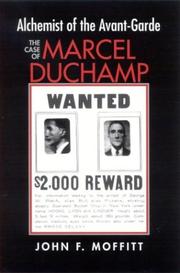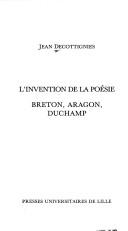| Listing 1 - 6 of 6 |
Sort by
|

ISBN: 0791486907 1417536047 9781417536047 9780791486900 0791457095 9780791457092 0791457109 9780791457108 0791457095 9780791457092 Year: 2003 Publisher: Albany : State University of New York Press,
Abstract | Keywords | Export | Availability | Bookmark
 Loading...
Loading...Choose an application
- Reference Manager
- EndNote
- RefWorks (Direct export to RefWorks)
Acknowledged as the "Artist of the Century," Marcel Duchamp (1887–1968) left a legacy that dominates the art world to this day. Inventing the ironically dégagé attitude of "ready-made" art-making, Duchamp heralded the postmodern era and replaced Pablo Picasso as the role model for avant-garde artists. John F. Moffitt challenges commonly accepted interpretations of Duchamp's art and persona by showing that his mature art, after 1910, is largely drawn from the influence of the occult traditions. Moffitt demonstrates that the key to understanding the cryptic meaning of Duchamp's diverse artworks and writings is alchemy, the most pictorial of all the occult philosophies and sciences.
Alchemy --- Metals, Transmutation of --- Philosophers' egg --- Philosophers' stone --- Stone, Philosophers' --- Transmutation of metals --- Chemistry --- Occultism --- Influence. --- Duchamp, Marcel, --- Sélavy, Rrose, --- Duchamp-Villon, Marcel, --- Villon, Marcel Duchamp-, --- Duchamp, Henri Robert Marcel, --- Dushan, Marsel, --- דושאן, מרסל --- デユシヤンマルセル, --- Duxiang, --- Sélavy, Rose, --- Criticism and interpretation. --- Sélavy, Rrose --- Villon, Marcel Duchamp --- -Duchamp, Henri Robert Marcel --- Dushan, Marsel --- Duxiang --- Sélavy, Rose
Book
ISBN: 2840163942 2840161230 Year: 2021 Publisher: Nanterre : Presses universitaires de Paris Nanterre,
Abstract | Keywords | Export | Availability | Bookmark
 Loading...
Loading...Choose an application
- Reference Manager
- EndNote
- RefWorks (Direct export to RefWorks)
Cet ouvrage porte sur la relation étroite de l'oeuvre de Marcel Duchamp avec la notion de l'Androgyne, la coexistence des principes mâle et femelle, hérités des mythes anciens de la création. Il porte également sur les idées platoniciennes, les pensées gnostiques, hermétique, et les croyances alchimiques telles qu'elles se trouvent exprimées dans le corpus de l'oeuvre de Duchamp. Il s'agit, dans un premier temps, de présenter le rôle et la signification de l'Androgyne dans les mythes anciens de la création, chez les philosophes grecs, dans la gnose, la philosophie hermétique des alchimistes et la cabale. Dans un second temps l'oeuvre de Marcel Duchamp sera abordée d'un point de vue de la figure « androgyne ». En particulier seront analysées de façon détaillée les deux grandes oeuvres de Duchamp, La Mariée mise a nu par ses célibataires même et Étant donnés: 1º la chute d'eau, 2º le gaz d'éclairage, en nous attachant à l'étude de leurs caractéristiques spécifiquement androgynes telles qu'elles ont été définies dans la première partie.
Duchamp, Marcel, --- Criticism and interpretation. --- Sélavy, Rrose --- Duchamp-Villon, Marcel, --- Villon, Marcel Duchamp --- -Duchamp, Henri Robert Marcel --- Dushan, Marsel --- דושאן, מרסל --- デユシヤンマルセル, --- Duxiang --- Sélavy, Rose --- Art --- mythe --- ésotérisme --- alchimie --- Duchamp --- gnose --- cabale

ISBN: 0520921011 0585263949 9780520921016 9780585263946 9780520213760 0520213769 0520213769 Year: 1998 Publisher: Berkeley (CA) : University of California Press,
Abstract | Keywords | Export | Availability | Bookmark
 Loading...
Loading...Choose an application
- Reference Manager
- EndNote
- RefWorks (Direct export to RefWorks)
Perhaps no twentieth-century artist utilized puns and linguistic ambiguity with greater effect-and greater controversy-than Marcel Duchamp. Through a careful "unpacking" of his major works, Dalia Judovitz finds that Duchamp may well have the last laugh. She examines how he interpreted notions of mechanical reproduction in order to redefine the meaning and value of the art object, the artist, and artistic production.Judovitz begins with Duchamp's supposed abandonment of painting and his subsequent return to material that mimics art without being readily classifiable as such. Her book questions his paradoxical renunciation of pictorial and artistic conventions while continuing to evoke and speculatively draw upon them. She offers insightful analyses of his major works including The Large Glass, Fountain and Given 1) the waterfall, 2) the illuminating gas.Duchamp, a poser and solver of problems, occupied himself with issues of genre, gender, and representation. His puns, double entendres, and word games become poetic machines, all part of his intellectual quest for the very limits of nature, culture, and perception. Judovitz demonstrates how Duchamp's redefinition of artistic modes of production through reproduction opens up modernism to more speculative explorations, while clearing the ground for the aesthetic of appropriation central to postmodernism.
Modernism (Art) --- Postmodernism. --- Duchamp, Marcel, --- Criticism and interpretation. --- Post-modernism --- Postmodernism (Philosophy) --- Art, Modernist --- Modern art --- Modernism in art --- Modernist art --- Sélavy, Rrose, --- Duchamp-Villon, Marcel, --- Villon, Marcel Duchamp-, --- Duchamp, Henri Robert Marcel, --- Dushan, Marsel, --- דושאן, מרסל --- デユシヤンマルセル, --- Duxiang, --- Sélavy, Rose, --- Arts, Modern --- Avant-garde (Aesthetics) --- Philosophy, Modern --- Post-postmodernism --- Aesthetic movement (Art) --- Art, Modern --- Sélavy, Rrose --- Villon, Marcel Duchamp --- -Duchamp, Henri Robert Marcel --- Dushan, Marsel --- Duxiang --- Sélavy, Rose
Book
ISBN: 3319691589 3319691570 Year: 2018 Publisher: Cham : Springer International Publishing : Imprint: Palgrave Pivot,
Abstract | Keywords | Export | Availability | Bookmark
 Loading...
Loading...Choose an application
- Reference Manager
- EndNote
- RefWorks (Direct export to RefWorks)
This book marks the centenary of Marcel Duchamp’s Fountain by critically re-examining the established interpretation of the work. It introduces a new methodological approach to art-historical practice rooted in a revised understanding of Lacan, Freud and Slavoj Žižek. In weaving an alternative narrative, Kilroy shows us that not only has Fountain been fundamentally misunderstood but that this very misunderstanding is central to the work’s significance. The author brings together Duchamp’s own statements to argue Fountain’s verdict was strategically stage-managed by the artist in order to expose the underlying logic of its reception, what he terms ‘The Creative Act.’ This book will be of interest to a broad range of readers, including art historians, psychoanalysts, scholars and art enthusiasts interested in visual culture and ideological critique.
Duchamp, Marcel, --- Criticism and interpretation. --- Sélavy, Rrose, --- Duchamp-Villon, Marcel, --- Villon, Marcel Duchamp-, --- Duchamp, Henri Robert Marcel, --- Dushan, Marsel, --- דושאן, מרסל --- デユシヤンマルセル, --- Duxiang, --- Sélavy, Rose, --- Fine arts. --- Aesthetics. --- Psychoanalysis. --- Culture-Study and teaching. --- Fine Arts. --- Cultural Theory. --- Psychology --- Psychology, Pathological --- Beautiful, The --- Beauty --- Esthetics --- Taste (Aesthetics) --- Philosophy --- Art --- Criticism --- Literature --- Proportion --- Symmetry --- Culture—Study and teaching. --- Radio broadcasting Aesthetics --- Aesthetics
Book
ISBN: 1283915707 1611683491 9781611683493 Year: 2013 Publisher: Hanover ; London : University Press of New England,
Abstract | Keywords | Export | Availability | Bookmark
 Loading...
Loading...Choose an application
- Reference Manager
- EndNote
- RefWorks (Direct export to RefWorks)
The dramatic story of art in the twentieth century
Art, Modern --- Modernism (Art) --- Artists --- Affichistes (Group of artists) --- Fluxus (Group of artists) --- Schule der Neuen Prächtigkeit (Group of artists) --- Zero (Group of artists) --- Art, Modernist --- Modern art --- Modernism in art --- Modernist art --- Aesthetic movement (Art) --- Duchamp, Marcel, --- Picasso, Pablo, --- Sélavy, Rrose, --- Duchamp-Villon, Marcel, --- Villon, Marcel Duchamp-, --- Duchamp, Henri Robert Marcel, --- Dushan, Marsel, --- דושאן, מרסל --- デユシヤンマルセル, --- Duxiang, --- Sélavy, Rose, --- Bīkāsū, Bāblū --- Luyisi Bikasuo, Babuluo --- Luzi Bikasuo, Babuluo --- Pikaso, Pablo --- Pikaso, Paburo --- Pikasso, Pablo --- Ruiz, Pablo --- Ruiz Picasso, Pablo --- Ruiz y Picasso, Pablo, --- Ruys, Pablo --- Ruys Picasso, Pablo --- פיקאסו --- פיקאסו, פאבלו, --- פיקאסו, פבלו --- ピカソパブロ --- Bijiasuo --- Influence. --- Sélavy, Rrose --- Villon, Marcel Duchamp --- -Duchamp, Henri Robert Marcel --- Dushan, Marsel --- Duxiang --- Sélavy, Rose

ISBN: 2757426281 2859394575 Year: 2020 Publisher: Villeneuve d'Ascq : Presses universitaires du Septentrion,
Abstract | Keywords | Export | Availability | Bookmark
 Loading...
Loading...Choose an application
- Reference Manager
- EndNote
- RefWorks (Direct export to RefWorks)
Prenons pour une date symbolique ce 4 octobre 1926, où André Breton, optant pour ce qu’il appelle le « comportement lyrique » décida d’incorporer à la fiction de l’être féminin qu’il cultivait depuis son adolescence une passante de la rue Lafayette qui répondait au nom de Nadja. N’est-il pas vrai que, par cette décision, il inventait ou réinventait pour son propre compte la poésie, c’est-à dire la vie poétique, cette utopie qu’entretenaient aussi certains de ses amis, et qu’avait illustrée déjà Louis Aragon sous le nom du Paysan de Paris ? La poésie, la vie poétique, ne saurait se confondre avec le métier d’écrivain. Elle fait, en revanche, une place de choix à la métaphysique et, plus encore, à l’amour. On ne s’étonnera donc pas que la figure féminine soit constamment au centre des préoccupations du poète surréaliste. Une figure qui n’appartient pas davantage au réel qu’à l’imaginaire, et mérite, de ce fait, la qualification de magique-circonstancielle. Une figure qui, de surcroît, se dérobe autant qu’elle s’offre, objet d’une jouissance mélancolique et répondant à la condition de cette beauté érotique-voilée qu’on reconnaît aisément dans la Mariée de Marcel Duchamp. Ce qu’on appelle ici l’Invention de la Poésie ne revendique pas le statut d’un événement historique inscrit dans l’évolution de la littérature. Pas plus que la poésie ne veut être confondue avec ce genre littéraire que le mètre et la rime suffisent à distinguer de la prose. Il s’agit bien plutôt d’une activité mentale, associée à une pratique du langage, susceptible de réformer notre rapport au monde et à autrui, notamment dans l’amour, lequel, écrit symétriquement Breton, est « à réédifier ».
French poetry --- Love in literature. --- Surrealism (Literature) --- History and criticism. --- Breton, André, --- Aragon, --- Duchamp, Marcel, --- Criticism and interpretation. --- Sélavy, Rrose --- Duchamp-Villon, Marcel, --- Villon, Marcel Duchamp --- -Duchamp, Henri Robert Marcel --- Dushan, Marsel --- דושאן, מרסל --- デユシヤンマルセル, --- Duxiang --- Sélavy, Rose --- A-la-kung, --- Andrieux, Louis, --- Arāghūn, --- Aragon, Louis, --- Aragon --- Aragông, --- Aragông, Lui, --- Arankon, --- אראגאָן, לואי, --- אראגון --- Routisie, Albert de, --- Saint-Romain, Arnaud de, --- La Colère, François, --- Témoin des martyrs, --- Breton, André --- Бретон, Андре --- poésie --- critique --- genèse --- Painting --- Poetry --- Aragon, Louis --- Duchamp, Marcel --- Breton, André --- Love in literature --- Women in literature --- Poésie française --- Amour dans la littérature --- Surréalisme (Littérature) --- Femmes dans la littérature --- History and criticism --- Histoire et critique
| Listing 1 - 6 of 6 |
Sort by
|

 Search
Search Feedback
Feedback About
About Help
Help News
News